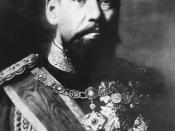01.05.2003
Social Studies
Japanese military, social, political and economic reforms
in the Meiji restoration
Military: In 1872 the Japanese military started to use conscription. This is same as drafting in the U.S.A. All conscripts had to serve a three year period in military service, after which they were put to reserves for four years. This system was introduced by Yamagata Aritomo, and the next year this same man set up the Japanese Imperial army. He favored and used the army style of Germany, and the naval style of the British. Some years later the Samurai system was abolished totally... Some Samurai were so upset, that they started a revolt.
Economic: The Bakufu was ended on 1868. In 1871 the Daimyo's were also dismissed, their land redistributed into smaller parts... Unlike the samurai, the Daimyo received a large pension to compensate the loss of their land. In 1872 there was a land redistribution program.
This was to become a more solid method than the previous system which relied totally on the price of rice... A straight 3% tax was levied on the land. The government also started to sell industries which used to make Military hardware to the private buyers...These people later grew to become the Zaibatsu, which could be described as big industrial empires controlled by one family.
Political: Feudalism in Japan was completely abolished during Meiji rule. Like most of Japan, also the parliament was altered heavily. Japanese government sent Ito Hirobumi to study the European parliament systems, and he especially favored the one of Britain. So the Japanese parliament, Diet, is based on the British parliament. It consists of Prime minister, upper and lower house. Hirobumi himself became the first prime minister and the upper house was made of the former nobility and the Daimyo's. The...


